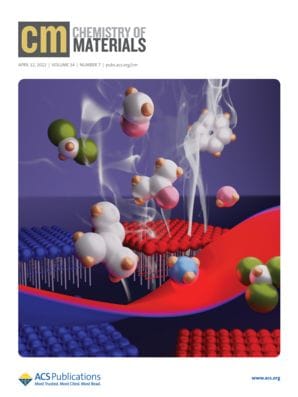This annual award honors the authors of a research article that has made notable impact within materials chemistry and also recognizes the team nature of the winning research.

Chemistry of Materials and the ACS Division of Polymeric Materials: Science and Engineering are excited to announce “Beyond the Threshold: A Study of Chalcogenophene-Based Two-Photon Initiators” for the 2024 Chemistry of Materials Lectureship and Best Paper Award, which honors the authors of an article published in 2022 or 2023 that has outstanding influence across materials chemistry and recognizing the team nature of research. This year's winning paper was authored by:
- Markus Lunzer*, UpNano GmbH, Austria
- Joseph S. Beckwith, University of Geneva, Switzerland
- Franziska Chalupa-Gantner, Technische Universität Wien, Austria
- Arnulf Rosspeintner, University of Geneva, Switzerland
- Giuseppe Licari, University of Geneva, Switzerland
- Wolfgang Steiger, Technische Universität Wien, Austria
- Christian Hametner, Technische Universität Wien, Austria
- Robert Liska, Technische Universität Wien, Austria
- Johannes Fröhlich, Technische Universität Wien, Austria
- Eric Vauthey, University of Geneva, Switzerland
- Aleksandr Ovsianikov, Technische Universität Wien, Austria
- Brigitte Holzer*, Technische Universität Wien, Austria
Sara E. Skrabalak, Editor-in-Chief of Chemistry of Materials, noted that this research reflects the very best in team science, bringing together diverse expertise to validate new chalcogenophene-based photoinitiators for two-photon polymerization. Their utility over a broad spectral window and operation at lower powers and concentrations compared to commercial initiators is an exciting advance, especially given the growing reliance on 3D-printing technology. These photoinitiators open the door to use economical low-power lasers and to operate multiple two-photon polymerizations in parallel, with potential to produce highly detailed 3D objects for diverse applications.

Beyond the Threshold: A Study of Chalcogenophene-Based Two-Photon Initiators
DOI: 10.1021/acs.chemmater.1c04002
Read the Interview with This Year’s Winners
We spoke with corresponding authors Markus Lunzer and Brigitte Holzer to learn more about their winning research.
How did this team come together to collaborate on this research?
Our paper presents the development of a series of powerful new photoinitiators for two-photon polymerization (2PP) and shows how these small molecules contribute to an efficient two-photon polymerization process. Step by step we put together an interdisciplinary team of material scientists including synthetic chemists, spectroscopists, physicists and application experts from both industry and academia. We started with the molecular design and synthesis of a series of nine symmetrically substituted chalcogenophenes at TU Wien (Austria), followed by a systematic investigation of their photophysical properties, especially their two-photon absorption properties, in collaboration with the Vauthey research group at the University of Geneva (Switzerland). Their expertise in ultrafast photochemistry and broad portfolio of custom-built experimental setups were invaluable to this study. To translate the photophysical findings into practical applications, we tested these small molecules as two-photon initiators using a home-built spectrally tunable 2PP setup with the Ovsianikov research group at TU Wien. Finally, after identifying a lead compound, we compared its performance with conventional photoinitiators using a commercial, state-of-the-art 2PP 3D printer from UpNano GmbH (Austria).
What challenges did you overcome on the way to getting the results you reported in your paper?
The strength of our article is the strong interdisciplinary approach across different disciplines of materials science, combining organic synthesis and ultrafast photo-physical characterization with a clear focus on the real-world application of the compounds as 2PP photoinitiators in industry. The diverse expertise of the collaboration partners led to innovative solutions that would be quite challenging for individual researchers to achieve on their own. However, compiling these collective efforts timely was not always straightforward and demanded the active support and contribution of every researcher involved.
What new research are you doing to build on the findings you described in your paper?
We are convinced that the findings in this paper will pave the way for the advancement of 2PP 3D-printing systems with more economical low power lasers or systems with multiple beams operating in parallel. While the advantage of our new photoinitiators in acrylate resin formulations are clearly demonstrated, different applications require specialized 2PP photoinitiators. Markus and Brigitte are collaborating to develop highly water-soluble 2PP photoinitiators that achieve the same precision in the fabrication of hydrogels. Moreover, we could recently show that 2PP resin systems based on highly efficient photoinitiators of this kind result in highly-cured photopolymers right out of the 2PP 3D printer, which do not require any further post-curing step, in contrast to other resin-based additive manufacturing technologies. This is a very important feature for many applications such as the production of highly porous structures or fabrication of integrated microfluidic devices.
What advice would you give to research teams who aspire to be where you are now?
Challenge your materials and collaborate with others! From the first idea, we allowed the properties of the materials to guide our further scientific direction, carefully investigating both their potential and limitations. This thorough study provided us with a broader perspective, helping us to better understand where to focus our efforts and how to advance the development as well as application of these materials. We sought the support of experts in their field to push the boundaries of our materials and seek innovative approaches. In this way, we were able to carry out this comprehensive research covering expertise from the design of small molecules to the final application.

